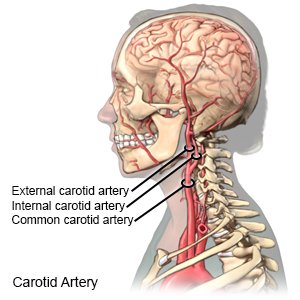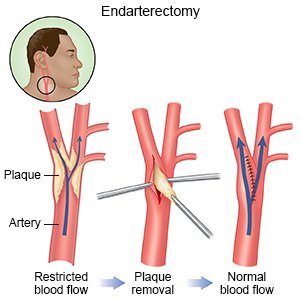Carotid Endarterectomy
Medically reviewed by Drugs.com. Last updated on Apr 6, 2025.
What do I need to know about carotid endarterectomy (CEA)?
CEA is surgery to remove plaque (fatty deposits) from inside your carotid artery. The carotid artery is a blood vessel found on both sides of your neck. Plaque may build up inside your carotid artery and decrease blood flow to your brain. A piece of plaque may also break free and cause a stroke.
 |
How do I prepare for surgery?
- Your surgeon will tell you how to prepare. You may be told not to eat or drink anything after midnight on the day of surgery. Arrange to have someone drive you home when you are discharged.
- Tell your surgeon about all medicines you currently take. Your surgeon will tell you if you need to stop any medicine for surgery, and when to stop. Your surgeon will tell you if you need to take aspirin or a blood-thinning medicine before surgery. This medicine will help stop clots from forming in your blood. Your surgeon will tell you which medicines to take or not take on the day of surgery.
- You may need blood tests before surgery. You may also need an ultrasound, CT scan, or MRI. Tell the healthcare provider if you have ever had an allergic reaction to contrast liquid. Do not enter the MRI room with anything metal. Metal can cause serious injury. Tell the provider if you have any metal in or on your body. The tests may be done to check the plaques in your carotid artery. Angiography may be used to check the blood flow from your carotid artery to your brain.
- You may need tests to make sure your heart is healthy enough for surgery. This may be needed if you have heart failure or are at increased risk for a heart attack.
Drugs used to treat this and similar conditions
Crestor
Crestor (rosuvastatin) is used to treat high cholesterol and high triglycerides in the blood ...
Plavix
Plavix (clopidogrel) is used to prevent blood clots after a recent heart attack or stroke. Includes ...
Ozempic
Learn about Ozempic (semaglutide) for type 2 diabetes treatment, weight management, cardiovascular ...
Xarelto
Xarelto (rivaroxaban) is a factor Xa inhibitor used to reduce the risk of blood clots and stroke in ...
Zontivity
Zontivity is used for the prevention of cardiovascular events. Includes Zontivity side effects ...
Vorapaxar
Vorapaxar systemic is used for peripheral arterial disease, prevention of atherothrombotic events ...
Rivaroxaban
Rivaroxaban systemic is used for atrial fibrillation, cardiovascular risk reduction, congenital ...
Rosuvastatin
Rosuvastatin is a prescription medication used to treat high cholesterol and prevent heart disease ...
Clopidogrel
Clopidogrel systemic is used for acute coronary syndrome, acute coronary syndrome, prophylaxis ...
Isoxsuprine
Isoxsuprine systemic is used for cerebrovascular insufficiency, coronary artery disease, raynaud's ...
What will happen during surgery?
- You will be given regional or general anesthesia to prevent pain during surgery. An incision will be made in your neck, over your carotid artery. Your surgeon will make an incision in the artery. The plaque will be separated from the artery wall and removed.
- The artery will be closed or put back together with stitches. An artificial patch or a piece of your own vein may also be used to close your artery. The blood flow through your carotid artery will be checked.
- A drain may be used to remove extra blood and fluid from around your artery. Your skin will be closed with stitches and covered with a bandage.
 |
What should I expect after surgery?
Healthcare providers will remove the bandage soon after surgery to check the incision. Do not get out of bed until your healthcare provider says it is okay.
- Your head will be kept straight for 24 hours after surgery. This helps lower your risk for side effects, such as swelling and fainting. The head of your bed may also be slightly raised.
- Medicines may be given to thin your blood to prevent blood clots. You may also need medicine to lower your cholesterol or blood pressure level.
- Ultrasound pictures may be used to look for clots in your carotid artery.
What are the risks of CEA?
- Muscles or nerves near your carotid artery may be damaged. Nerve damage may lead to changes in how you look, or trouble chewing and swallowing. You may bleed more than expected or develop an infection. You may have headaches, high blood pressure, or abnormal heartbeats. Swelling in your surgery area may block your airway. A fistula (abnormal connection) may form between your carotid artery and another tissue. You are also at risk for a life-threatening heart attack during or after surgery.
- You may get a blood clot in your leg, arm, or carotid artery. The clot may travel to your heart or brain and cause life-threatening problems, such as a heart attack or stroke. After CEA, your carotid artery may become narrow or full of plaque again. The patch used for your surgery may tear or loosen, causing a large amount of blood loss.
Care Agreement
You have the right to help plan your care. Learn about your health condition and how it may be treated. Discuss treatment options with your healthcare providers to decide what care you want to receive. You always have the right to refuse treatment. The above information is an educational aid only. It is not intended as medical advice for individual conditions or treatments. Talk to your doctor, nurse or pharmacist before following any medical regimen to see if it is safe and effective for you.© Copyright Merative 2025 Information is for End User's use only and may not be sold, redistributed or otherwise used for commercial purposes.
Further information
Always consult your healthcare provider to ensure the information displayed on this page applies to your personal circumstances.
